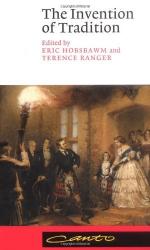
|
| Name: _________________________ | Period: ___________________ |
This quiz consists of 5 multiple choice and 5 short answer questions through Chapter 4, The Context, Performance and Meaning of Ritual, The British Monarchy and the 'Invention of Tradition', c. 1820-1977.
Multiple Choice Questions
1. In the first period, the power that the monarchs wielded made grand ceremonies _______ as did royal unpopularity.
(a) Fitting.
(b) Unacceptable.
(c) A spectacular media event.
(d) Necessary.
2. According to the book, the Welsh were once addicted to ________ and fortune tellers, long after their popularity died out in England.
(a) Healers.
(b) Poets.
(c) Magicians.
(d) Psychologists.
3. During the third period, the royal rituals helped to comfort people during times of _______.
(a) Winter.
(b) Change.
(c) Plenty.
(d) Starvation.
4. Although descendants of the ______ kings challenge later books in terms of accuracy, the book in question #53 was never challenged.
(a) William.
(b) Stuart.
(c) Wallace.
(d) Hapsburg.
5. According to the book, the Rev. Macpherson helped start a cultural re-writing process that lasted for a _______.
(a) Year.
(b) Decade.
(c) Century.
(d) Milennium.
Short Answer Questions
1. The book asserts that the creation of invented traditions helps historians make sense of human relations in the _______.
2. Hobsbawm asserts that the overtly or tacitly accepted rules of traditions must have a ______ nature.
3. The invented traditions referred to in question 17 include all of the following types except _______.
4. The author suggests that invented traditions have mostly arisen in the last ______ hundred years.
5. According to the book, the minister of ______ wrote a Critical Dissertation, in which he provided the context for Macpherson's transposed locations.
|
This section contains 232 words (approx. 1 page at 300 words per page) |

|




